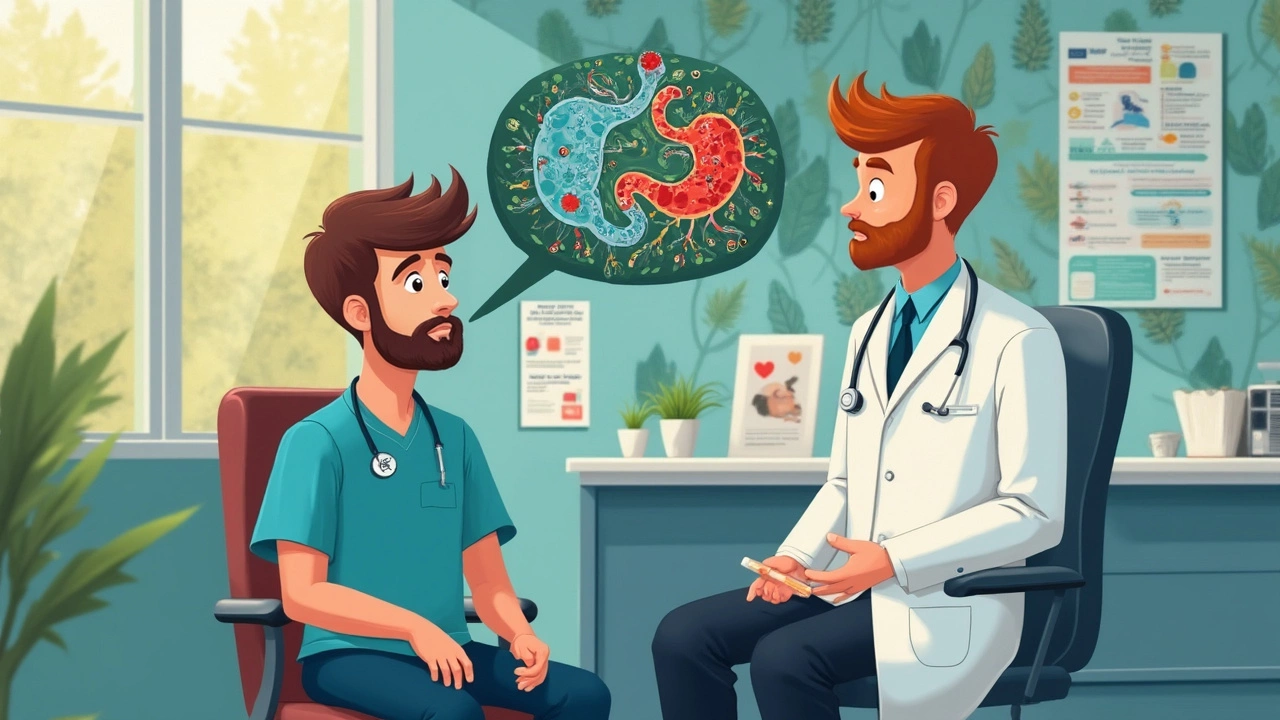Ever had to take antibiotics and then ended up practically living in the bathroom? You're not the only one. Some antibiotics blast through bad bacteria but also trash the friendly ones in your gut. This can leave you feeling bloated, crampy, and sometimes even give you relentless diarrhea.
What really matters is knowing which antibiotics are the worst culprits. Doctors often prescribe these without always telling you about the possible gut chaos. If you've ever taken clindamycin or broad-spectrum stuff like amoxicillin-clavulanate, you probably know that groaning gut feeling.
So, how can you protect your gut while dealing with whatever infection won’t go away? Stick around—I'll break down the basics, name the nastiest antibiotic offenders, and give you straightforward tips for handling antibiotics like a pro. If you do need a prescription, especially from an online doctor, you’ll know what questions to ask and what signs you should watch for so you can keep your gut in check.
- How Antibiotics Affect Your Gut
- The Main Offenders: Antibiotics That Damage the Gut Most
- Why Gut-Friendly Choices Matter
- Tips to Protect Your Gut During and After Treatment
How Antibiotics Affect Your Gut
Here’s the honest truth: antibiotics don’t have a smart filter. When you swallow a pill, it doesn’t just attack the infection—you’re also wiping out tons of helpful bacteria in your gut. Think of your gut as a little city full of good and not-so-good residents. Antibiotics can flatten whole neighborhoods, leaving things out of balance and messing with digestion, immunity, and even your mood.
One of the biggest problems is wiping out your normal gut bacteria (they call it your 'gut microbiome'). These are the bacteria that help you break down food, absorb vitamins, and even fight off nasty germs in the future. Destroying these means higher chances of diarrhea, food sensitivities, and, in the worst cases, serious infections like C. diff (which can land you in the hospital).
Here’s what commonly happens in your gut when you take antibiotics:
- Gut health takes a hit: You can lose up to a third of your healthy bacteria after just a single course of antibiotics.
- The space left from the “good guys” being gone means bad bacteria can move in. Hello, stomach aches and gas.
- Some antibiotics knock things out for just a few days, but others can mess up your gut for months.
- Your immune system struggles. About 70% of your immune cells live in your gut—when the bacteria are off, so is your body’s defense.
Ever notice how sometimes you suddenly feel run-down during or after an antibiotic course? There’s a reason. Without the right bacteria, it’s harder to fight viruses, deal with stress, or recover energy. When you talk to your doctor—even an online one—ask about gut side effects. Not all antibiotics are equally harsh, and some gut-friendly habits can help you rebound quicker.
The Main Offenders: Antibiotics That Damage the Gut Most
Not all antibiotics are created equal when it comes to tearing up your gut. Some are like dropping a bomb in a flower garden—they wipe out way more than just the bad bugs. Here’s the scoop on which ones cause most of the trouble.
The biggest gut-wreckers are broad-spectrum antibiotics. These go after many types of bacteria, not just the ones making you sick. The top offenders?
- Clindamycin: This one is notorious for causing C. diff infections, a nasty kind of diarrhea that can linger for weeks.
- Amoxicillin-clavulanate: Docs love it for sinus and ear infections, but it’s tough on your gut health and known for triggering diarrhea.
- Ciprofloxacin and other fluoroquinolones: These hit everything, including the good bacteria keeping your gut balanced.
- Cefixime, cefdinir, and other cephalosporins: Broad-spectrum, so they clear out large swathes of bacteria in your intestines.
- Macrolides like azithromycin and clarithromycin: These aren’t as brutal as the others above, but they still mess with your microbiome.
If you’re curious just how risky these are, check out the table below. It shows what percentage of people run into gut problems with some common offenders.
| Antibiotic | Risk of Diarrhea | Risk of C. diff Infection |
|---|---|---|
| Clindamycin | ~20% | High |
| Amoxicillin-clavulanate | 5–25% | Moderate |
| Ciprofloxacin | 5–10% | Moderate |
| Cephalosporins | 8–15% | Moderate |
| Macrolides | Up to 10% | Low |
That’s not just uncomfortable—long-term changes to your microbiome can stick around for months. One study out of Stanford even found that some people’s good bacteria never fully bounced back after certain courses. So it’s more than just a few days of loose stools.
"Antibiotics are a leading cause of disruptions in the gut microbiome, sometimes leaving patients vulnerable for weeks to months after a single dose." – Dr. Martin Blaser, microbiome researcher, NYU
The reason is simple: these antibiotics don’t just kill the invaders, they can also nuke the helpful bacteria that keep your gut calm, your digestion on track, and even your immune system in good shape. If you need to take any of these, it's worth asking your doctor if there’s a narrower or milder option that targets just what’s necessary.

Why Gut-Friendly Choices Matter
When doctors talk about antibiotics, the focus is usually on fighting infection fast. But picking a more gut health-friendly antibiotic can save you a world of trouble later. Your gut is packed with bacteria—trillions of them, in fact—and they do everything from breaking down food to making vitamins and keeping your immune system on track.
When certain antibiotics wipe out more of these good bacteria than others, that’s when problems start. Clindamycin, amoxicillin-clavulanate, and cephalosporins top the list for gut disruption—they can drop your gut bacteria diversity by 90% within days. That huge drop leaves you more open to annoying stuff like bloating, but also to serious infections like C. diff (which causes really nasty diarrhea).
“Antibiotic treatment, particularly with broad-spectrum agents, is a leading driver of gut dysbiosis and can have long-lasting effects on microbiome recovery.” — British Journal of Pharmacology
What’s even more intense? After just one round of broad-spectrum antibiotics, it can take months for your gut to bounce back. For some folks—especially the elderly—some strains don’t come back at all.
| Antibiotic | Gut Disruption Risk | Estimated Recovery Time |
|---|---|---|
| Clindamycin | Very High | 3–6+ months |
| Amoxicillin-Clavulanate | High | 2–5 months |
| Ciprofloxacin | High | 2–4 months |
| Doxycycline | Moderate | 1–3 months |
If you have a choice (and often you do, especially if you ask), aiming for narrow-spectrum antibiotics whenever possible helps. These target just the bacteria causing your infection, not your bystander gut bacteria. And if you’re doing an online doctor consultation, bring it up—you’re not being picky, you’re being smart.
- Ask your doctor if a narrow-spectrum antibiotic will work for your infection.
- Mention any past gut issues—like IBS or trouble with antibiotics before. This can help your provider choose better.
- Look for early signs of gut problems (loose stools, stomach gurgling) and bring them up right away. Quick changes in the prescription can help protect your microbiome.
Trust me, it’s much easier to prevent gut chaos than deal with it after the fact.
Tips to Protect Your Gut During and After Treatment
If you have to take antibiotics, especially the ones toughest on your gut, a little planning goes a long way. The first thing to know: the good bacteria you lose can often be rebuilt with the right habits. You don’t have to just cross your fingers and hope for the best.
- Antibiotics shouldn’t always be paired with dairy products. Antibiotics like tetracyclines and some penicillins can become less effective when taken with milk or yogurt. Follow your doctor’s instructions about timing if you’re taking these meds.
- Eat plenty of fiber-rich foods like whole grains, beans, vegetables, and fruits. These help feed the good bacteria. Researchers from the American Gut Project found fiber boosts gut bacteria variety, especially after antibiotics.
- Take probiotics, but not at the same time as your antibiotics. Space them out by at least 2–3 hours so the probiotic actually survives. Look for strains like Lactobacillus rhamnosus or Saccharomyces boulardii. One review found they cut the risk of antibiotic-related diarrhea by around 42%.
- Stay hydrated, especially if you’re dealing with diarrhea. Water, broths, and drinks with electrolytes can help keep your body balanced.
- Don’t stress about ‘sterilizing’ your gut. A lot of people worry about the damage forever, but studies show most gut bacteria bounce back within a few weeks after finishing antibiotics, as long as you eat well and avoid unnecessary meds.
- If possible, ask your doctor if a more narrow-spectrum antibiotic can treat your infection. The more targeted the medication, the less likely your gut flora will get wiped out.
Quick fact: Here’s how long it usually takes for your gut bacteria to bounce back depending on the type of antibiotic you took.
| Antibiotic Type | Average Recovery Time (Gut Bacteria) |
|---|---|
| Amoxicillin | 7–14 days |
| Ciprofloxacin | 1–3 months |
| Clindamycin | Up to 6 months |
If symptoms like nonstop diarrhea, blood in your stool, or severe belly pain stick around after antibiotics, talk to an online doctor or your GP. Sometimes, those friendly bacteria need a little more backup than yogurt and good vibes.
